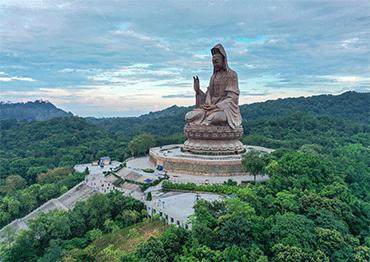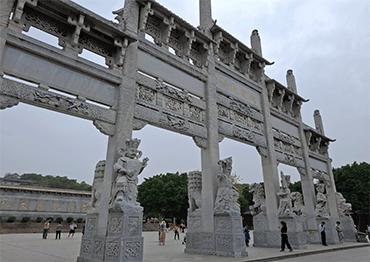Xiqiao Shan (Mount Xiqiao) in Foshan, Guangdong Province is an aural paradise. While our modern world often feels overwhelmed by the din of electronic appliances, the air around Mount Xiqiao is filled with the distinct and mesmerizing sound of fresh running water. This is hardly surprising considering the locals boast the scenic area contains 232 springs and 28 waterfalls. The dense tropical forests covering the mountain are home to abundant wildlife, with birdlife presenting an endless chorus of soothing melodies, while insects chirp enthusiastically. Away from the access roads, with their quiet buzz of electric tourist vehicles, the only man-made sounds come from the occasional distant gong of a temple’s sacred bell. How different the sounds must have been 50 million years ago, when Mount Xiqiao was still spewing lava and ejecting molten rocks into the atmosphere.
Mount Xiqiao has been designated as a national forest park and a national geological park. Although the park is typically referred to as being a singular mountain, it contains an abundance of mountain peaks and forest areas. Not all these different areas are as tranquil as each other, and some are very popular with tourists. However, the variety of attractions at Mount Xiqiao are part of the charm. Indeed, they ensure that visitors have reason to spend multiple days visiting the area, alternating between areas of fascinating culture and areas of organic serenity. You can visit any time of year. However, due to extensive walking required it is recommended to avoid periods of extreme heat, or times when storms are likely.
The most famous attraction is Nanhai Guanyin Culture Park, which contains a monumental 66-meter-high statue of Guanyin, known as the goddess of mercy. This statue sits atop one of the area’s many peaks, and on a clear day offers an incredible vista across much of southern China’s Greater Bay Area. The statue sits above a curious hall of religious idolatry and art, much of it painted with lurid, yet appealing colors, or smothered in glittering gold. To reach the Guanyin, visitors need to ascend through Baofeng Temple. The temple is built over multiple terraces and contains numerous devotional halls containing statues of deities and other revered figures. Despite the popularity of the temple, its immense scale ensures that visitors can find their own space to contemplate, or indeed worship, in peace. The combined area of Baofeng Temple and the Nanhai Guanyin Culture Park is easily enough for any visitor to enjoy two to three hours. It also includes ascending a fair number of steps. For that reason, visitors may not wish to arrive at the temple having already hiked their way up the mountain. Many therefore choose to take advantage of the affordable shuttle bus, which brings people to the temple entrance.
For visitors who seek authenticity or are fascinated by the more traditional elements of Chinese culture, the entrance to Baofeng Temple sits next to a tiny, ancient, but still inhabited mountain village. The village can be accessed by a tiny pathway to the right of the temple’s main visitor entrance. Considering the immense throng of visitors that explores the temple and ascends to meet Guanyin, almost no-one seems to visit the adjacent village. However, the locals are friendly and are very happy to sell basic supplies to those who venture in. Indeed, there is something strikingly poetic about the juxtaposition between a Guanyin taller than the Statue of Liberty, golden shrines and Buddhas, and the modest reality of this humble village.
The area has other opportunities to entice those who are particularly interested in culture and history. For example, close to Mount Xiqiao is the village of Song Tang, which can trace its origins back over 800 years. Despite being a relatively small settlement, Song Tang contains a large number of ancestral halls as well as family temples and family schools. Another cultural attraction is Luzhou Village, with its Huang Fei-hong Lion Dance and Martial Arts Academy, which has a fascinating history.
However, for most visitors to Mount Xiqiao, the primary draw is nature. The volcanic history of the mountains ensures that the area is as rich in geological curiosity as it is rich in botanical diversity. The geological importance of this area is not new to modern civilization, as evidenced by the ancient quarry that sits in the heart of the magnificent Shiyan Cavern. However, the most popular geological feature is Baiyun Cave. In addition to the “three cave paradises” that make up Baiyun Cave, the area includes features such as Kuiguang Tower, built by wealthy local families in the late 18th century to encourage the community’s youth to perform better in imperial examinations, and Dashing Torrent Waterfall, otherwise known as the Xiqiao Cloud Waterfall.
Another attractive area to visit within the Mount Xiqiao range is the Nine Dragons Cavern, an area of plunging valleys that features dramatic geological formations including caves that seem destined for a Gothic drama. In addition to the caves, the valleys around the Nine Dragons Cavern include a biodiverse selection of flora and fauna. In many areas, the human impact has been minimized, and nature has been allowed to take its course, resulting in a dense jungle atmosphere, where all creatures great and small can scurry about their daily business, free from the dangers that humans pose them.
Dotted across Mount Xiqiao is also a fabulous assortment of semi-wild scenic zones, where specific plant species have been introduced or cultivated over the centuries. Many of these areas trace their history back hundreds of years, again highlighting the importance of Mount Xiqiao to the history of Southern China. Some of the most important scenic zones to visit include the Peach Garden with its romantic blossoms, the Sweet-Scented Osmanthus Garden with its aromatic trees, the Rhododendron Garden featuring over 100 varieties of fragrant rhododendron, the Sifang Bamboo Garden featuring an eponymous species of bamboo unique to the mountain, and the Camellia Garden blessed with over 50 species of gorgeous camellias.
Finally, it would be a real shame to visit Mount Xiqiao without taking a relaxing stroll around Tianhu Lake. This former ancient crater offers a beautiful respite from modern life, with the energizing ions from the water combining with the fresh oxygen from the forest to rejuvenate even the weariest traveler. With peaceful wooden walkways, and carefully positioned viewpoints, it is no wonder that people have fallen in love with this area repeatedly over the centuries, and why Guanyin herself feels so at home.

 Old Version
Old Version

